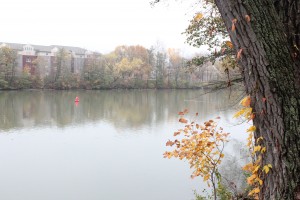Each day, whether by walking across the footbridge that leads to the Riverview Apartments or singing our alma mater, we are reminded of our neighbor to the East: the Genesee River. While useful and, at certain times, beautiful, the river is also a major concern; its levels of pollution top national scales.
Initial investigation on the pollution of the Genesee helped to discern some of what caused the problem. According the Department of Environmental Conservation, one of the last thorough inspections of the river was conducted in 2003.
The Genesee is an integral part of the lives of University students and faculty alike and its title as one of the nation’s most polluted rivers has sparked both jest and concern.
In a report entitled “Water Inventory for Lower Genesee River Watershed,” published by the NYS Department of Environmental Conservation, the segments of water that stretch from the lower portion of the Genesee in Pennsylvania to the city of Rochester that were tested were all reported as possessing a degree of pollution, including labels ranging from “minor impacts” to “impaired,” and even some segments denoted as “threatened.”
The criteria for these judgments include the ability to support fish and aquatic wildlife, recreational uses such as fishing and boating and the possibility of use as public bathing and drinking water.
The Genesee River ranks 32nd among American rivers in total toxic discharges, according to a March 23 article in the Democrat and Chronicle.
The U.S. Environmental Protection Agency (EPA) claims that the Genesee River contained 1,393,966 pounds of discharge in 2010, of which 97 percent was found to be nitrate compounds deposited from the Eastman Kodak Company. The other three percent of waste was reported to be from Friendship Dairies, a dairy in upstate New York that services many states in the northeast, which, like Kodak, had been dumping waste into the Genesee for many years.
As UR is located alongside the Genesee River, students utilize the amenities provided by the water and the surrounding area on a regular basis which makes its pollution an issue on campus.
One such privilege the river offers is the Genesee Riverway trail system that runs adjacent to the Genesee, traveling through popular locations such as Genesee Valley Park and the historic Corn Hill neighborhood.
In addition to the popular trail system, UR’s sports teams that use the Genesee come in even more direct contact with the polluted river. For example, the men’s club and women’s varsity crew teams use the Genesee River to practice, regularly rowing each morning when most students are still asleep.
“As someone who regularly is on the Genesee, I can say that I fear that the toxins will somehow affect the team,” freshman coxswain Amy Elias said. “There’s actually a running joke among coxswains that those of [the team] that have accidentally been dumped into the water will mutate in the future.”
Despite this jest, pollution of the Genesee River is still a major concern.
In January 2003, a press conference was held regarding the growing concern of the city being labeled as one of the top cities in the nation that suffers from the effects of cancer-causing releases of industrial chemicals.
According to the minutes from the conference, the Eastman Kodak Company ranked ninth among the country’s worst polluters three years earlier in 2000 as reported by both the New York Public Interest Group and the Citizens’ Environmental Coalition. Although, in 2000, the two groups set out to call on federal officials to begin trying to minimize human exposure to toxins, an issue that has remained prevalent, even to the present day.
Although the safety and cleanliness of the river is questionable, its role in campus life is not. At least a few UR students will take the plunge each year. That being said, not every student is up for the feat.
“I would only go in if I were paid or were receiving some sort of reward for doing so,” sophomore Allie McFarlane said.
Senior Ally Abel felt similarly, but considered the river, and jumping into it, part of UR tradition.
“Although I’ve heard multiple horror stories of what lies within the water of the Genesee, it is something that everyone needs to do before graduating,” she said.
Whether or not these horror stories are true, the polluted Genesee has garnered attention from national organizations.
Groups including the EPA have taken the initiative to make efforts in cleaning the Rochester Embayment, the Monroe County section of the Genesee River. Five sites that were beyond the potential for clean-up and classified as considerable threats to the health of Rochester natives as well as the environment have been closed, preventing any further harmful exposure.
Local groups hope that by working to decrease the public threat of the contaminated Genesee the city will become more environmentally-conscious someday.
Numerous local politicians, along with scientists from Strong Memorial Hospital have been making an effort to improve the conditions of the Genesee as well, conducting studies since 2003 to monitor the improvement of the river.
One such study involves the use of freshwater, bottom-feeding fish known as sturgeon that were tagged and released into the embayment area of the river. The researchers conducting this study have routinely tested the tissue of the sturgeon, hoping to see a gradual decrease in the negative effects on the species.
According to the observed data, the Genesee River has become a healthier and safer environment as a result of the now nine-year-long study.
Efforts like this one are currently the most effective methods for decreasing the pollution of the river.
And, just as in our treasured Alma Mater, “the river gath’ring force, along her steadfast way…[grows] stronger day by day,” the levels of contamination and pollution in the Genesee River will hopefully eventually degrade, restoring the river to its original unadulterated state.
Lerner is a member of
the class of 2016.





